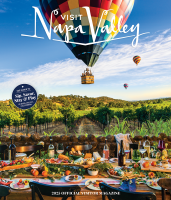What's most popular in Napa Valley?
Although Cabernet Sauvignon and Chardonnay are the most widely planted, the Napa Valley holds many surprises for wine lovers looking for varieties off the beaten path. From Albariño to Zinfandel, more than three dozen different wine grape varieties flourish in the Napa Valley.
Below is a description of the most widely planted grape varieties in Napa Valley.
For more information, please visit Napa Valley Vintners
Variety or Varietal?
Variety can refer to either the grape itself (Cabernet Sauvignon, Chardonnay), or to the style or kind of wine, as in red, white, or sparkling, etc.
Varietal is used to describe a wine made from a single variety of grape.
So, a glass of Chardonnay would be a varietal wine, made from Chardonnay variety grapes.
Cabernet Sauvignon
Cabernet Sauvignon is the acknowledged king of red grapes in Napa Valley, accounting for 40% of our total production and 55% of our crop value. This vine is grown throughout Napa Valley and achieves a variety of expression depending on its vineyard site. Its flavors display a wide variety of black fruits, including currant, cherry and plum, and often show notes of spice from oak aging.
Food pairing: When young they are best matched with robust red meat dishes such as game and braised lamb, while older Cabs are superb accompaniments to simply prepared roasts and steaks and aged cheeses.
Chardonnay
Chardonnay is the second most planted grape variety in Napa Valley, and grows with particular success in the calcium-rich soils and cool climate of the Los Carneros AVA, where it can ripen slowly. Barrel fermentation, lees stirring and malolactic fermentation are the main winery techniques used to create complex aromas and flavors in this wine. As a result, Napa Valley Chardonnay can range in style from fresh, crisp and lively to rich, round and buttery.
Food pairing: This wide range of styles can accompany a wide variety of dishes, from simply prepared seafood to most pork and poultry dishes.
Merlot
Merlot has been a fixture in the Napa Valley since the early 1970s. Its lovely aromas of ripe cherry and rich earthiness, a soft texture and a smooth finish have appealed to a new generation of red wine drinkers. Given the diversity of vineyard sites and winemaking practices in Napa Valley, Merlot has shown itself capable of producing both lighter and full-bodied, richly textured wines.
Food pairing: Pair Merlot with food much in the same way as you would Cabernet Sauvignon, although its lighter body and tannins make it a versatile partner to a wide range of dishes.
Pinot Noir
The earthy, ethereal aromas and silky texture of Pinot Noir have beguiled wine connoisseurs for centuries. Coastal California possesses several areas that produce great Pinot Noir, and Napa Valley's Los Carneros was one of the first to recognize its potential. One of the hallmark qualities of Pinot Noir is its bright acidity, which makes it a versatile partner with food.
Food pairing: Pinot Noir is one of the few red wines that pairs well with seafood (think salmon, tuna and bouillabaisse), a wide variety of cheese and is absolutely perfect with game birds and grilled lamb chops.
Sauvignon Blanc
The intense flavor profile of Sauvignon Blanc grabs your attention. Herbaceous, grassy notes and vibrant acidity are hallmark qualities of this grape, and it is capable of showing a wide variety of fruit character. Most Sauvignon Blanc is fermented in neutral vessels, such as stainless steel and concrete eggs, to allow its distinctive varietal character to shine through.
Food pairing: Fresh and bright and perfect for warm weather, Sauvignon Blanc goes great with light summer fare and salads and is wonderful with shellfish and goat cheese.
Zinfandel
An exceedingly versatile grape variety, Zinfandel was the mainstay of 19th century winemaking in California. Old vines in Napa Valley are capable of producing rich, heady, jammy wines with notes of spice and black pepper. Zinfandel is also made in lighter, more food-friendly renditions and is often used as the base for fortified wines.
Food pairing: The bold, spicy character of Zinfandel makes it a perfect partner with barbeque.















